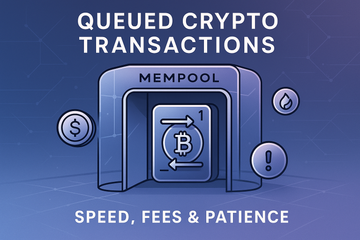Picture this: you've just pressed 'send' on a crypto transaction, maybe buying a little more ETH or swapping coins on a favored app. You feel that slight rush of adrenaline—will it go through quickly? Or, like so many others, will it hang for a moment, shuffling its feet at the front of the blockchain? Welcome to the fascinating (sometimes frustrating) phenomenon of the queued transaction.
So, What Does 'Queued' Really Mean in Crypto?
In the bustling world of cryptocurrencies, a queued transaction is a little bit like waiting in line at a busy coffee shop. You've placed your order, but before your name is called, the barista needs to check off a few others ahead of you. The transaction sits in the digital lobby—the mempool—waiting its turn for validation. Only then can it step up to the counter (well, the blockchain) and truly become official.
Simple, right? Sort of. But let's be honest: you might find yourself tapping your foot, wondering why on earth there's a wait in a system that's supposed to be lightning-fast. Let me explain.
The Mempool: A Digital Holding Pen
Every blockchain—whether it's Ethereum, Bitcoin, or something newer—has what’s called a mempool. Think of it as a big, unseen digital waiting room. When you send a transaction, it lands here first, queued up alongside thousands of others from around the globe.
But here's the twist: not every transaction gets treated the same. Some are prioritized based on transaction fees, network congestion, or sometimes even the whims of miners eyeing their own profit margins. Kind of like when people tip the barista extra for a quicker coffee—those who 'pay up' (via higher gas or miner fees) move to the front of the line.
Why Does Waiting Happen? The Real Deal With Congestion
You might be thinking, 'All that tech, and I'm still stuck in line?!' Well, yes. The underlying reason is simple: limited block space. Each block can only fit so many transactions, and the whole system is constantly balancing speed, cost, and—quite crucially—security.
- Network Traffic: During big events (NFT drops, token launches), demand can spike dramatically.
- Fee Wars: Users raising gas fees to cut the line during high congestion.
- Technical Glitches: Sometimes, nodes slow down or syncing issues crop up, creating small backlogs.
Remember when the internet felt sluggish every evening because the whole neighborhood jumped on Netflix? Same vibe. But now, it's savvy traders, NFT hunters, and investors all piling on at once.
Queued Transactions: Triumphs, Troubles, and a Little Bit of 'Why Me?'
Let’s get real—having a transaction stuck in queue can feel panic-inducing, especially when the price wiggles or you’re watching the blockchain explorer like a hawk. Sometimes the transaction sits for minutes, sometimes hours. Once, during a buzzworthy NFT release, I waited nearly half a day and felt every tick of the clock.
But before you panic-cancel or re-submit, it’s worth pausing. Repeatedly re-sending the same transaction might just create a bigger tangle, especially if your wallet isn’t set to automatically bump up fees. And, believe it or not, this scenario is where the choice of your tool really matters. Wallets like Ledger and Trezor help manage transaction queues elegantly. They display real-time transaction status, allow fee adjustments, and sometimes let you nimbly 'replace by fee'—jumping ahead by offering a sweeter tip to the network.
Small Tangent: The Human Side of Crypto Tech
You know what? There’s a mental dimension often overlooked in crypto discussions. The anxiety of 'Is my money gone? Is it stuck forever?' is real. Even seasoned users feel a flicker of worry when a transaction vanishes into that holding pen. It’s almost funny how a technology billed as instantaneous can bring us back to that familiar, slightly helpless feeling of waiting—just like at the DMV, but globally and with possibly higher stakes.
How to (Mostly) Avoid Getting Stuck: A Few Practical Pointers
Is there a magic wand to make queued transactions vanish? Not exactly. But a couple of simple habits can tip the odds in your favor:
- Check network status: Before sending, see how busy the blockchain is. Websites like Etherscan and Mempool.space offer live data.
- Don't skimp on fees: Sure, nobody loves paying extra, but a fair gas fee often translates to faster processing.
- Pick your wallet wisely: Devices from Ledger or Trezor give granular control over fee adjustment.
- Stay patient: Sometimes, simply waiting a bit longer does the trick. The queue really does move.
And remember, sometimes things resolve on their own—your transaction eventually passes through, a small blip in your crypto journey. If only real-world lines worked out so well.
The Bigger Picture: Why Queues May Never Fully Disappear
Even with clever upgrades and continual tinkering, queued transactions are likely here to stay—at least for the foreseeable future. The very design of blockchains is to trade off absolute speed for security, integrity, and a level playing field for everyone. If you ever wondered why we don't just let any transaction through instantly, just recall what happened with payment fraud in the early days of e-commerce. Patience is, strangely enough, a big part of keeping the whole ecosystem fair and safe.
Some chains, like Solana or Polygon, are trying to handle more traffic with novel approaches. But there's always an upper limit, and as you might’ve guessed, the 'morning rush' problem comes for even the fastest chains.
Wrapping Up: The Waiting Game Is Part of the Adventure
To sum it up, queued transactions are the unsung sidekicks of every crypto story. Sometimes they’re invisible; sometimes, they’re at the center of all your worries. But with a little know-how, the right wallet (shout out again to Ledger and Trezor), and a dash of patience, managing them isn’t too daunting.
Next time you hit 'send' on a blockchain transaction, just remember: it’s not stuck, it’s waiting its turn. And isn’t that a tiny bit reassuring?











